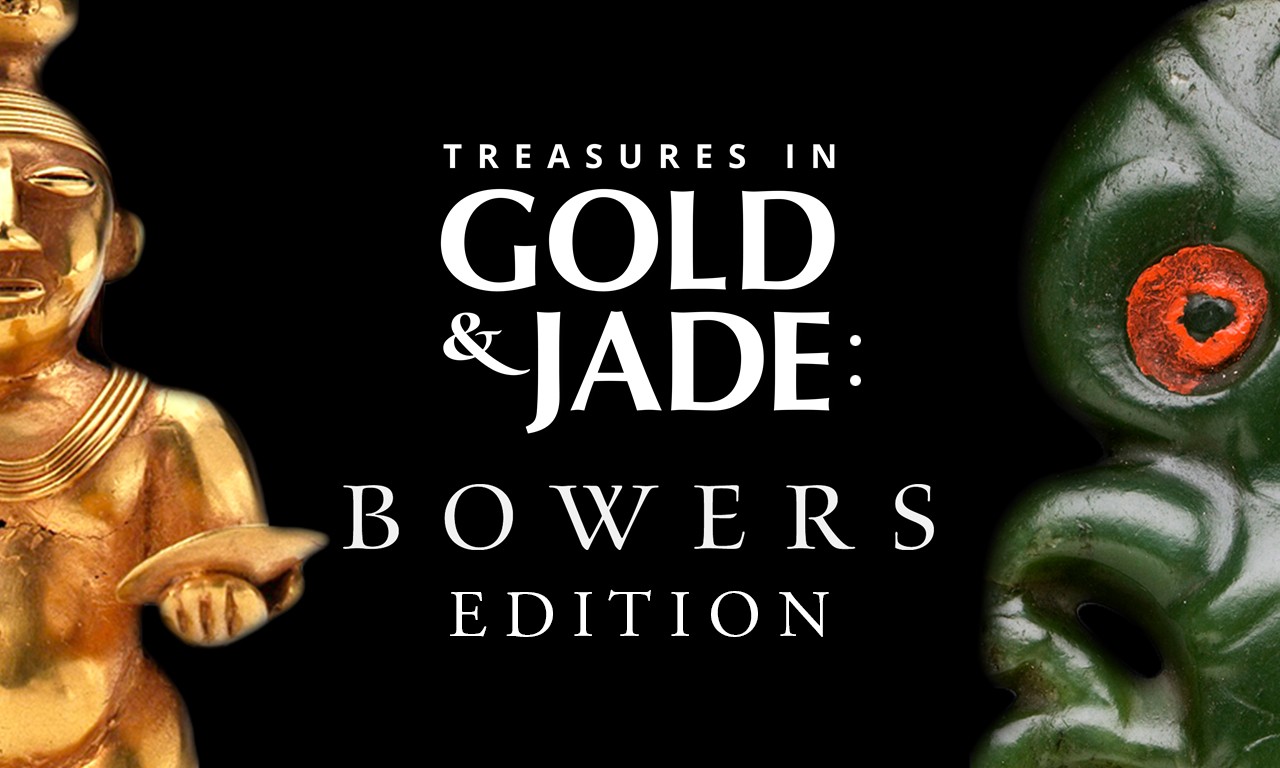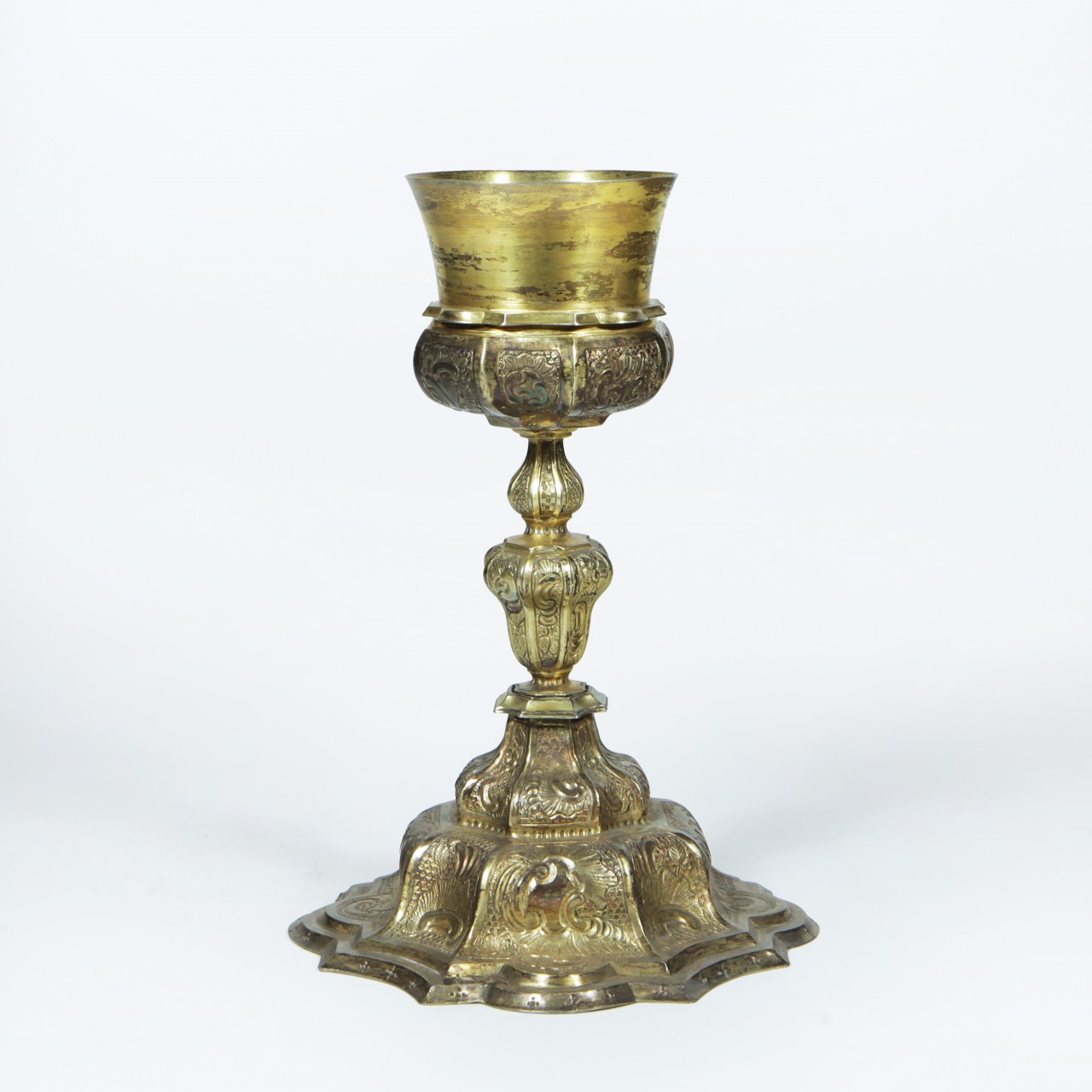2002 North Main Street
Santa Ana, California 92706
TEL: 714.567.3600
Treasures in Gold & Jade: Bowers Edition

Rare Mediums, Done Well
Despite being closed to the public the Bowers Museum is excited to announce that this Saturday is the virtual opening of our long-awaited Treasures in Gold & Jade: Masterworks from Taiwan, featuring pieces from two artists: Wu Ching who creates gold casts from wood carvings and Huang Fu-shou who carves sculptures from jade. Given the plethora of guides, tours and programs related to the exhibition that will soon be available on the Bowers’ website, this post instead looks at the properties of gold and jade and some of the most notable pieces made of those mediums in Bowers’ collections.
![]()
Old as Gold
Gold is a brilliant yellow metal which has been hailed for its unique properties for thousands of years. In many cultures it became the most valuable commodity and was used as a high-denomination currency and in the form of fashioned jewelry. Gold is the most malleable of all metals which allows one ounce of it to be beaten into an ultra-thin sheet measuring approximately 300 square feet. Another of its historic uses has been in gilding, covering the surface of just about any object in a gold sheets to make it appear that it is entirely made from the metal. As opposed to jade, which is always carved, gold can be worked in a multitude of ways. Just in this post the gold objects were made by the metal being mixed with other materials to create alloys, being hammered and then decorated with a repoussé technique, and being cast with the same lost-wax technique used by Wu Ching. As we can see, none of the pieces display any signs of tarnish. One of the properties of gold is that even after thousands of years it retains its bright luster.
 |
Gold Ear Ornaments (Kwottenai) These are earrings worn by married women of the Fulani culture of Mali. Commonly fashioned of 14 carat gold, they are either given as an heirloom by a mother to a daughter or are purchased as a gift by a husband for his wife. They serve to proclaim a woman's status, wealth, and esteem. |
 |
Ornament with Feline Figure (Vincha) Hammered gold, repoussé headdress ornaments, such as this exceptionally large one, are attributed to the Nazca culture of southern Peru. Two pairs of perforations on either side of the central faces suggest that the object may have been worn affixed to a turban or a headdress although there is some indication it purely served as a funerary mask. |
 |
Lime Container (Poporo) Gold containers like this were used by the Quimbaya culture of Colombia to hold a mixture of lime and coca leaves. Just like with the gold sculptures of Wu Ching, this piece was created using lost-wax casting. The figure of a cacique would have originally been molded from beeswax. |
 |
Chalice This is a chalice used in the family chapel of Don Bernardo Yorba. It is unclear exactly where he acquired it, but it likely came from Mexico originally. Rather than being made of pure gold it was cast from an alloy. |
 |
Modjeska’s Ring After a particularly inspired performance in Rome, this became one of three gold rings which were taken off and thrown at the feet of the famous Polish-born thespian Madame Modjeska. Gold jewelry is often given to women by admirers, though generally by hand rather than gentle lob. |
![]()
Made Like Jade
While thought of as a verdant, green gemstone, jade is an umbrella term for two different stones which, despite different mineral compositions and crystalline textures share many similarities. Varying shades of green are the most characteristic colors for both stones, however, chemical impurities such as the presence of iron can cause especially nephrite to take on a wide spectrum of colors. Jadeite comes in a deeper shade of green called “imperial jade” for its use in China’s imperial household during the Qing dynasty. Along with a rare variety of lavender jadeite, imperial jade is the most valuable subtype of the stone. Further lending to this value is that jadeite was only discovered in the 18th century and has only been mined in commercial quantities from Northern Burma. Jade’s unique crystalline structure has made it an ideal medium for a wide array of objects including weapons, currency pieces, personal adornment, décor and furnishings, astronomical instruments and more.
 |
Amulet (Hei Tiki) One of the most recognizable pieces of adornment in the Bowers Museum’s Spirits and Headhunters exhibition, this is a hei tiki from the Māori culture of New Zealand. Most think of worked Jade pieces as being exclusively from the area around China, but nephrite deposits are found in many places around the world. Several theories exist as to the significance of this amulet including its function to increase fertility, and the possibility it represents a human infant being birthed. |
 |
Fighting Club (Mere Parava) This teardrop-shaped club is made of nephrite, a material exclusively reserved for noblemen and chiefs in Maori culture. This club was both a symbol of power and a practical weapon. The design of the club made it suitable to strike a blow to the upper-body or head of an opponent in hand-to-hand combat. No matter which way the club was oriented when used, it produced lethal results. The hole carved out in the handle made it possible to suspend the club from the wrist or waist when not in use. |
 |
Brush Washer Due to the tastes of the Qianlong Emperor and the discovery of new sources of nephrite and jadeite, Qing Dynasty China saw a huge rise in the production of jade carvings. Milky white jade was mostly used during this period by scholars who preferred the older style of jade and believed in its spiritual properties: that it possessed five virtues conveyed in Confucian moral teachings, had preservative qualities, and was associated with immortality. |
 |
Frog Carving There is a long history of jade figures in China, first appearing in the round in the Shang Dynasty (1600-1027 BCE). This piece is of relatively contemporary make, illustrating that the jade carving industry in China is still alive thousands of years later. Pendants, particularly those in the shape of animals were among the most common jade carvings. |
 |
Belt Buckle In Qing Dynasty China belt buckles were made in the style seen in this example as well as in the style of archaistic belt hooks from the Warring States Period. Belt buckles such as this would have resided on a scholar’s desk rather than being worn. |
For more on Treasures in Gold & Jade: Masterworks from Taiwan click here for the link to the exhibition's page on the website.
Text and images may be under copyright. Please contact Collection Department for permission to use. References are available on request. Information subject to change upon further research. Image credits follow in respective order:
Gold Ear Ornaments (Kwottenai), 20th Century
Fulani culture; Mali
Gold and yarn; 9 × 8 1/2 in.
97.13.1.1-.2
Gift of Bowers Museum Collectors Council
Ornament with Feline Figure (Vincha), 1st Century BCE to 3rd Century CE
Possibly Nazca culture; South Coast, Peru
Gold; 12 3/4 x 19 in.
2005.26.1
Dr. James Block Pick and Dr. Rosalyn M. Laudati Fund Purchase
Lime Container (Poporo), 1000-1500
Quimbaya culture; Colombia
Gold; 2 1/2 × 1 in.
2006.1.1a,b
Gift of Greg and Mechas Grinnell in memory of Armand Labbe
Chalice, c. 1858
Mexico
Gold alloy; 9 1/4 x 6 1/2 in.
8010
Gift of Idalia Yorba Borchert
Handmade Gold Ring Inset with Pearlescent Stone, date unknown
Maker unknown
Gold, stone; 1 ½ x 1 3/16 in.
4946
Presented to Museum by Myrtle Blakeslee in memory of Felix Modjeska, grandson of Madame Helena Modjeska
Amulet (Hei Tiki), 18th Century
Māori culture; New Zealand, Polynesia, Oceania
Nephrite and sealing wax; 3 x 2 x 1/2 in.
2009.10.1
Bowers Museum Purchase
Fighting Club (Mere Parava), 17th to 18th Century
Māori culture; New Zealand, Polynesia
Nephrite; 10 1/4 x 3 1/4 x 3/4 in.
2002.18.3
Bowers Museum Purchase
Brush Washer, late 20th Century
China
Jadeite and wood; 4 5/8 x 4 in.
91.36.4.1
Gift of Mr. George Brooks
Frog Carving
China
Jade; 1 15/16 x 3 3/8 x 3 3/4 in.
97.31.11
Gift of Herbert Hansen
Belt Buckle, Qing Dynasty (1644-1912)
China
Jade; 3/4 × 5 × 1 3/4 in.
2017.11.30a,b
Gift of Anne and Long Shung Shih

Comments